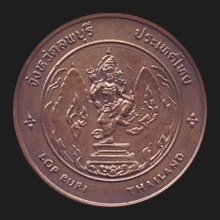|
Lopburi (ลพบุรี)
Thai. Name of a Thai province as well as of
its capital city (map),
located
in Central Thailand,
153 kms North of
Bangkok,
on the east side of the Chao Phraya river valley, between the
Lopburi
and
Pa Sak
rivers. The city today has
a population of around 40,000,
whereas the province houses almost
750,000
residents. In the past it was a
Mon city inhabited as early as the
Dvaravati period, from the 6th to the 11th century AD, when it was named
Lavo. When the
Khmer expanded their
Angkorian empire in the 10th century it absorbed Lavo, thus erasing all traces of the existing Lavo civilization. It became an outpost of the ancient Khmer empire and a provincial capital.
During the 12th century Khmer strength started to decline and some form of
self-government was given back to Lopburi which in 1115 AD sent a first
independent embassy to China. In the 13th century rule over Lopburi was wrested
entirely from the Khmer by the increasing powers of
Sukhothai to the North,
but Khmer cultural influence remained to a certain level throughout the
Ayutthaya
Period.
There is some evidence that in the 14th century King
U-Thong might have ruled over Lopburi, as part of the
Ayutthaya
Kingdom. In the
17th century, King
Narai (fig.) fortified the city to serve as a second capital when
Ayutthaya was threatened by a Dutch naval blockade.
His palace
on the east bank of the Lopburi River in Lopburi, where he (map
-
fig.) died in 1688, was built in 1665.
It is known as Phra Narai Rajanivet (map
-
fig.)
and its remains are
today one of the city's many historical
places of interest.
Lopburi today
is famous for the biggest military
base in Thailand, its numerous historical ruins (fig.),
the
Phra Kaan Shrine (map
-
fig.),
as well as many stray monkeys, for whom the local
people annually organize a monkey buffet.
Other places of interest include
the
Floating Rail
(map
-
fig.) over
Pa Sak
Chonlasit Lake with its Chonlasit
Pa Sak Dam (map
-
fig.),
Sunflower
Fields (map
-
fig.),
Mon,
Khmer,
Lavo and
Dvaravati
historical sites
(fig.),
etc. This province has eleven
amphur.
See also
Lopburi data file.
回






|

